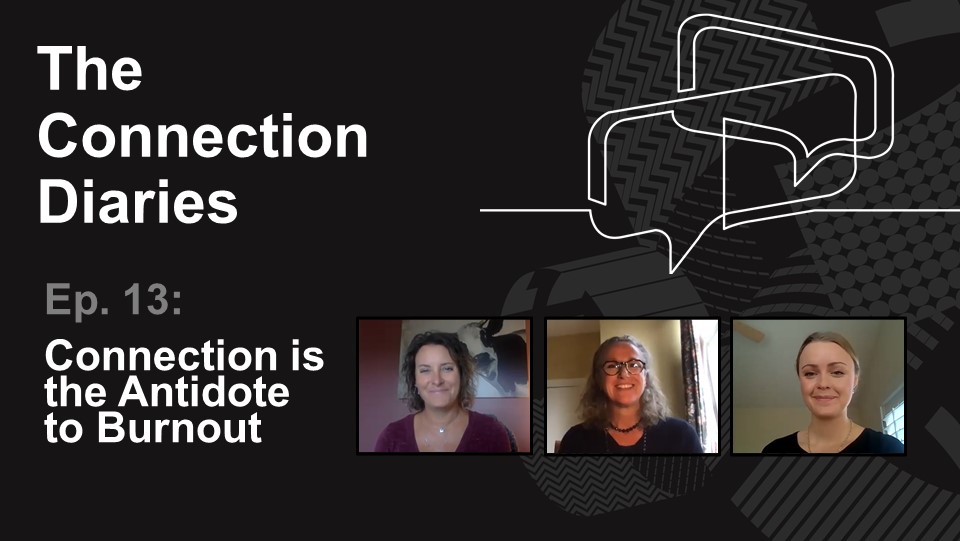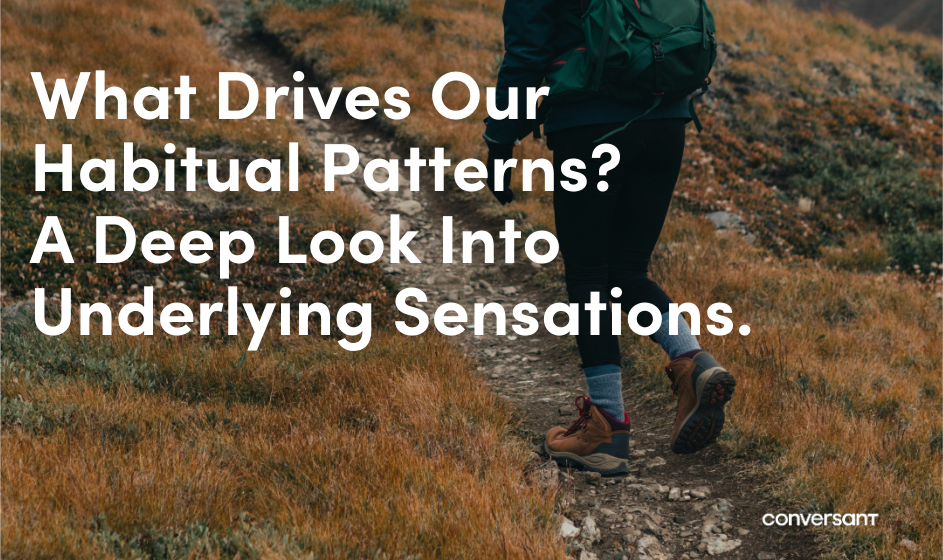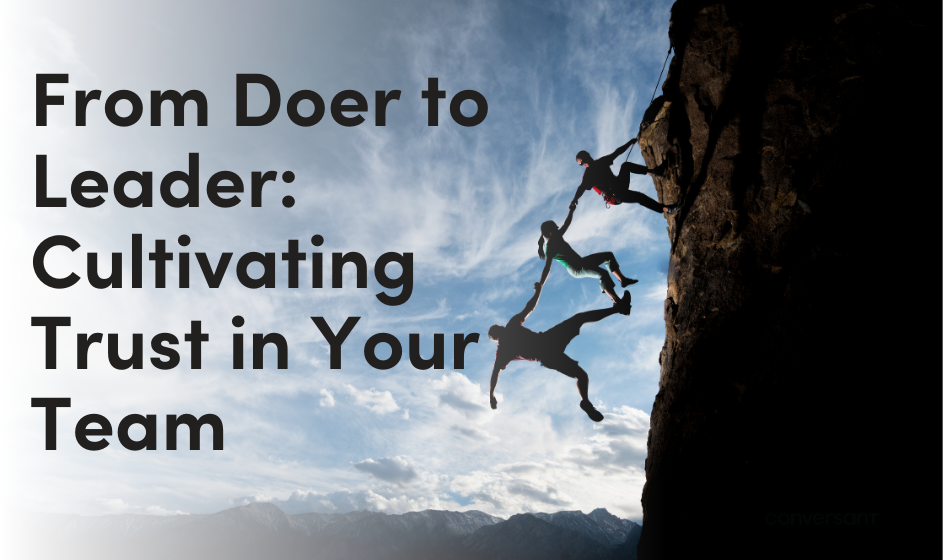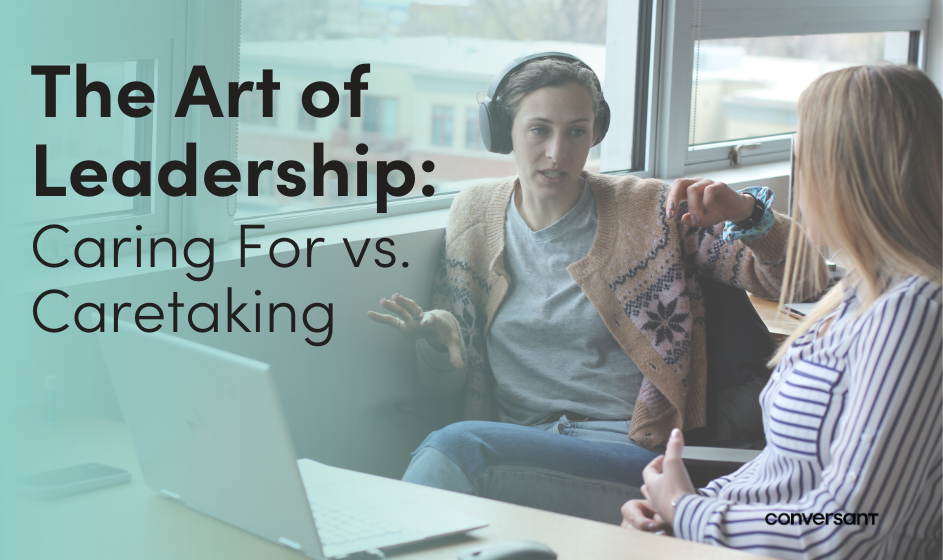Burnout. We’re all feeling it and leaders everywhere are worried about it. It’s been a wild year and circumstances we all saw as temporary have become a new normal: working from home (along with all its other responsibilities and distractions), an increased workload and longer workdays, less movement, fewer social occasions and a constant underlying anxiety. It’s no wonder so many are overwhelmed and losing steam.
Our first reaction to experiences like burnout and anxiety is often to retract. These are very normal, human reactions to events in our lives but in most cases, especially at work, we see it as a problem to keep to ourselves for fear of judgment, retaliation or a loss in credibility.
Paradoxically, research shows that the antidote to these emotions is more connection, not less. While we might want to retreat and hide until things have calmed down, the answer is actually to lean in.
In this episode of The Connection Diaries, Robin Anselmi, Evelyn Jonkman and Emma Rose Connolly share a few practical ideas for how to lean in, reconnect and prevent burnout on your teams:
1. Legitimize it
Leaders have to be willing to bring these issues up and ask how people are really feeling, then give them space to answer however they’re going to answer. We recommend that leaders go first in these conversations, sharing what they’re noticing or experiencing themselves and inviting others to share more authentically. Not only does this help to reduce stigma and normalize the topic, it also gives everyone permission to be more open and honest about their own challenges. When they know it’s normal and that they’re not alone, they’ll be more reliable for raising any issues early rather than waiting for big breakdowns.
2. Make space for spontaneous conversation
We’re all missing the casual water cooler conversation and quick visits from colleagues to our desk at the office. When challenges come up, where we used to catch our teammates between meetings or go grab a coffee with them to discuss, now we have to schedule yet another Zoom call on our packed calendars.
Working virtually, many are finding that our conversations have become very transactional, following an agenda meeting after meeting without much time to chat about non-work topics. Allowing and creating space for some spontaneity in our time with coworkers is an important way to stay connected and creates opportunities for people to be more candid about their challenges and where they might need help.
- One of our colleagues often hangs out in a Teams meeting when he’s checking email or doing simple tasks in case anyone wants to drop in to say hello.
- Some of us have a standing bi-weekly lunch meeting with no agenda, and we often catch up about on a whole range of things: what podcasts we’re listening to, what we’re excited about, where we’re struggling and what’s big on Netflix.
- This could also be as simple as dedicating the first 10 minutes of a meeting to checking in, asking everyone to share: How are you doing? What’s your workload like this week? How can we help? (remember, leaders should go first!)
3. Try a walking meeting
Changing your environment, getting fresh air and moving your body are all tried and tested ways of resetting. Movement is also great for your brain, and walking while talking helps us process our conversations and can inspire more creative and deep thinking. Walking meetings can give you and your colleague(s) a chance to take a revitalizing break from the long string of Zoom meetings and eye strain, and you’re more likely to retain whatever it is you discussed.
4. Practice Presence!
We believe presence and personal awareness is one of the most important things you can practice for increasing your effectiveness as a leader and teammate, and for your well-being. Try a few of the practices in our Presence Practice Library – just 10-15 minutes of your day can make a difference.
If you’re facing these challenges right now, we would love to hear from you. What questions are you wrestling with? Is there anything you’d love advice from other leaders on how to handle? What have your organizations been doing that’s working well? Comment below or connect with us on LinkedIn! Let’s unleash our collective brilliance.
Full Transcript
Robin: Hi everyone, welcome to this month’s edition of the Connection Diaries. I’m Robin Anselmi, and I’m joined today by Emma Rose Connolly and Evelyn Jonkman. Hi Youtube. Last month, we talked about mental health and well-being. We’re going to take another spin on that topic today but really focusing in on burnout. I don’t know if both of you are feeling it, but we’ve been hearing so much about it from clients, and there’s been a lot written about it recently about how, given sort of all the circumstances in the world, how people are really starting to experience burnout, and as we move into sort of the next season and what could be happening with quarantine and covid, people are really worried about, well, how are we going to mitigate this when people are already sort of feeling the onset of burnout. So Ev, what do you think about it? How do you think about burnout?
Evelyn: Well, it’s really interesting because with burnout, what you tend to react and do is you tend to retreat, and you tend to sort of protect yourself and put your guards up and push away from the problems, and so you’re actually losing connection. And interestingly, if you think about the science, it actually says that the more connection you have, the more you connect with people, the more you’re able to discuss it, the more you lean into it, the more likely you begin to feel empathy around it. It’s not just my problem, it’s actually a shared problem. It’s actually normal; it’s okay to talk about it. And so it’s interesting how, you know, our reaction is to this, but actually, the way to actually treat it is actually to come in and talk to people. What are you seeing, Emma Rose?
Emma Rose: Yeah, I mean, I think that given how isolated we all are right now, it’s really easy to get in our own heads about that we’re the only ones feeling the way that we’re feeling, and it’s—we’re under extremely strange circumstances—everyone—so sharing and being open about things, or at least finding opportunities to see that that’s reflected in somebody else, I could find so healing, of course. But it’s interesting that it is—the connection part is the antithesis, which we’re all sort of at a disadvantage of right now, but we just need to be more proactive about it.
Evelyn: Yeah, well it’s interesting because if you think about it further, you know, where a lot more people are experiencing burnout as Robin suggested, and we’re actually experiencing anxiety, burnout, and parts of depression, and they’re on the rise. But what we’re also noticing is it’s actually a human response to external factors that are actually hitting me, and so it’s a very normal human response, yet we still tend to think about these things as being bad, and we shouldn’t talk about them, we shouldn’t deal with them, we should shove them in the back corner. And if we actually start to say, actually it’s okay, because I’m just showing that I’m normal actually, and I’m just showing I’m actually a functioning normal human person that has these reactions. Can we just figure out some strategies? You’re actually starting to actually deal with it and open up and not to be so ashamed of it, and I think that’s a really strong thing for leaders to start thinking about, is to legitimize it, normalize it, actually even say it’s a really healthy thing to be doing, so please let me know if you’re going through this and I’m here to help.
Robin: So I think today, you know because it is so normal to retreat, let’s talk about what are a couple of really practical things that leaders can do that we think are doable, easy, at least a move in the right direction? So Ev, I think you started down the path on one which is, just legitimize it. So actually be willing as a leader to bring it up in a conversation with people around, how are they really feeling? Right, and actually give space for them to answer however they’re going to answer, and you know, you may have to go first as the leader in that conversation around, here’s some of the things you’re noticing for yourself. Are they experiencing any of those things? So it both puts you in the game with them in that conversation and then gives them space to be able to know that it is normal and that they’re not alone, to your points about that.
Evelyn: Yeah, and I think actually your point about leaders going first is really good. I think that if the leader shows up saying, “You know, I’m actually having a bad day today,” or, “I haven’t got as productive as I normally am,” or, “I’ve got lots of interruptions and I’m—you know, is anybody else finding this a difficult environment to actually be normal and do functional work in?” That makes other people feel it’s permission to do the same, and I think we know that the productivity rates are really high. People are working really hard and they’re producing lots of things, but we’re reducing it to transactions. I’m just getting as much done on my to-do list, and that’s not making me feel thriving, or feel energetic, or creative either, so I’m running on empty, and so, you know, giving me some time to say, “I need not to be productive today,” you know, it would help, you know? And if you’re having those days, and I can—I’m given permission to have those days as well.
Robin: Which I think brings us to a second point, right, that because the space has become so transactional—so many of our meetings are “let’s just get through this”—we’ve lost this feeling of spontaneity that we have in office places, right? Where I’m going to get a cup of coffee and stop by Emma Rose’s desk to chat for a moment, or the meeting and… hang for a couple extra minutes before the next one. So Emma Rose, ideas about how do we inject maybe just a little bit of spontaneity into this Zoom world that we’re all living in?
Emma Rose: Yeah sure, well I know—I mean, what we’ve done for a while now is some of our meetings the first 15 to 20 minutes every once in a while end up being checking in and just asking, “How are you? What’s your workload like? What do you need help with?” And we’ve found that some of those more agenda-less conversations are really healing and a nice lift on our day, and we do feel more connected. We also have a colleague who, he will—when he’s just doing email or working on whatever that’s a little bit less intense, he can post in Teams, “Hey, I’m going to be on this call if you want to just pop in and say hello and have a chat. Let me know.” So you’re kind of getting that water cooler-esque sort of opportunity to chat. Things like that I think are great, and trying to be proactive about it, too. I think so often we expect in that, you know, not legitimized space to be saved from our loneliness or from our fear of being found out that we’re not doing so well. But maybe just reaching out to maybe the person that you’re the closest with on your team and checking in. Things like that, you know, just not assuming that you’re alone I think is important.
Robin: Our last tip, some of you have probably heard us say before, we think is a really simple one and we find so many people don’t do it. But try a walking meeting. Ev, you want to say a little bit about why we think a walking meeting is such a rational idea?
Evelyn: Not irrational? Well because it actually changes your environment, and we know when you change your environment you’re likely to actually be changing the brain waves of your head, so you’re starting to see different things and think differently. Also just generally getting fresh air is really good for you and healthy. Also just changing, you know the way—move your body. So all these things contribute to changing the dynamics of how you are, and I don’t know about you, but I sit at the screen far too often, and my eyes hurt by the end of the day. So actually, having a walking meeting on the phone, it just feels different. It feels like I’m back to the old world again, and it just helps you think differently.
Robin: It doesn’t matter that I’m walking in Richmond, Virginia, and Emma Rose is walking in Boulder, Colorado, right? So—
Evelyn: Or I’m in Amsterdam!
Robin: Right. And we think there’s a theme that runs through all of this, and we have some ideas about that as well.
Emma Rose: Yeah, so we like to preach the value of presence all the time. We think it underlies everything in how we operate in our life and also on our teams in our business world. So we think that you should probably think about maybe prioritizing that, and we have a full library of presence practices. Just 10 to 15 minutes of taking a moment, checking in with yourself, how do I feel today, how can I name that, what’s the experience in my body, and some of that can just—number one, give you a place to stand from which to communicate with other people what you need, but also maybe presence is you to what you might need to give yourself that day. We invite you to check that out and we’ll link it below here, and maybe try it out with your team. Maybe set up a 15-minute slot on the calendar and put it on your Zoom, and see how you like it.
Robin: So thanks everybody for joining us for this month’s Connection Diary, and we look forward to seeing you again next month. Stay safe. Wash your hands.




